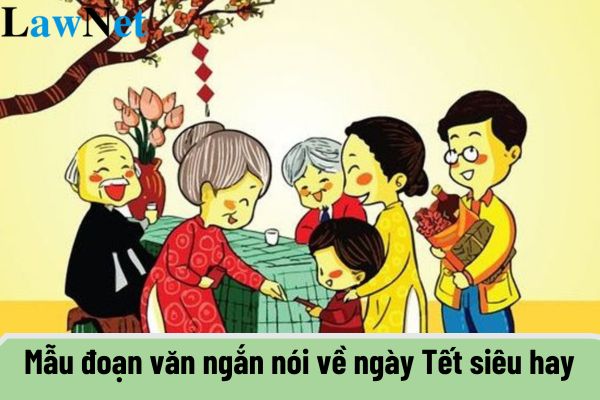Vietnam: What are the sample short paragraphs about Tet Holiday? What are the characteristics of the Literature subject in the new general education program?
What are the sample short paragraphs about Tet Holiday in Vietnam?
Writing the short paragraphs about Tet Holiday in Vietnam is practiced in the 3rd-grade Vietnamese Language curriculum.
3rd-grade students may refer to the following sample short paragraphs about Tet Holiday in Vietnam:
|
Sample short paragraphs about Tet Holiday in Vietnam 1. Tet Holiday – The Fresh New Spring |
*Note: The information is for reference only./.*

What are the sample short paragraphs about Tet Holiday? What are the characteristics of the Literature subject in the new general education program in Vietnam? (Image from the Internet)
What are the characteristics of the Literature subject in the new general education program in Vietnam?
According to the Appendix issued with Circular 32/2018/TT-BGDDT regarding the Literature subject in the general education program:
- Literature is a subject in the field of Language and Literature Education, taught from grade 1 to grade 12. At the primary education level, this subject is called Vietnamese; at the lower and upper secondary education levels, it is called Literature.
- Literature is an instrumental and aesthetic-humanistic subject; it provides students with the means to communicate, serves as a foundation for studying all subjects and educational activities; it is also a vital tool in educating students on high cultural, literary, and national linguistic values, fostering healthy emotions, humanitarian sentiments, benevolent, altruistic living,...
- Through linguistic texts and vivid artistic imagery in literary works, via reading, writing, speaking, and listening activities, Literature plays a substantial role in helping students form and develop good qualities as well as core competencies to live and work effectively and to engage in lifelong learning.
- The content of Literature is comprehensive, encompassing cultural knowledge, ethics, and philosophy,... related to various subjects and educational activities such as History, Geography, Arts, Civic Education, Foreign Languages, Natural and Social Sciences, Experiential Activities, Career Orientation,... Literature closely relates to life; it helps students pay attention to and connect with everyday life, relate, and possess problem-solving skills for real-world issues.
- The core content of the subject includes fundamental, essential knowledge and skills about Vietnamese and literature that meet the required standards of student qualities and competencies at each educational level; it is divided into two phases: the basic education phase and the career-oriented education phase.
- Basic Education Phase: The program is designed around core strands corresponding to reading, writing, speaking, and listening skills. Vietnamese and literary knowledge is integrated during the reading, writing, speaking, and listening instruction process. The language materials are selected and organized according to the students' levels of receptivity at each educational level.
- The goal of this phase is to enable students to use Vietnamese proficiently for effective communication in life and to perform well in other subjects and educational activities; to form and develop literary competence, an expression of aesthetic competence; simultaneously cultivate thoughts, and emotions to develop students' souls, and character.
- Career-Oriented Education Phase: The program reinforces and develops the results from the basic education phase, helping students enhance their language and literary competencies, especially in literary text reception; strengthen the skills of creating argumentative texts and informational texts of greater complexity in content and writing techniques; provide some practical knowledge of literary history and literary theory in terms of reading and writing; continue to nurture thoughts, emotions, soul, and character so students become responsible citizens.
- Additionally, within each year, students oriented toward social sciences and humanities can choose to learn specific study topics. These topics aim to enhance literature and language knowledge, the skill of applying knowledge to practice, and meeting students' interests, needs, and career orientation.
What are the perspectives on developing the Literature curriculum under the new general education program in Vietnam?
Under Section 2 of the General Education Program on Literature as promulgated by Circular 32/2018/TT-BGDDT:
- The Literature curriculum is developed on theoretical and practical foundations, updates on research achievements in education, psychology, and teaching methodology of Vietnamese literature; achievements in literature and linguistics research; achievements in Vietnamese literature across various periods; experiences in developing Vietnamese literature curricula, particularly from the early 21st century until now, and international trends in curriculum development in general, and the Literature curriculum in particular over recent years, especially from developed countries; societal practice, education, economic conditions, and Vietnamese cultural tradition, especially the diversity of students in terms of regions, conditions, and learning abilities.
- The Literature curriculum focuses on training communication skills (reading, writing, speaking, and listening) as a central theme throughout all three education levels to meet the program's capacity-oriented direction and ensure coherence and continuity across all grades and levels. Fundamental, foundational knowledge about the Vietnamese language and literature is formed through activities in comprehending and creating texts; directly serving the requirement of training in reading, writing, speaking, and listening skills.
- The Literature curriculum is developed with an open approach, reflected in not specifying detailed teaching content but stipulating the outcomes needed in reading, writing, speaking, and listening for each grade; delineating some basic, core knowledge about the Vietnamese language, literature, and some texts with a significant, crucial position in national literature as mandatory content for students nationwide.
- The Literature curriculum meets both the innovation requirements and emphasizes inheriting and enhancing the strengths of existing Vietnamese literature curricula, especially the current one.

